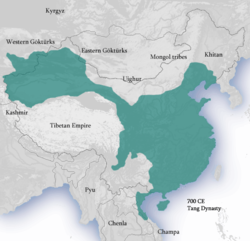Tang Empire
| Tang dynasty | ||||||||||
| 唐朝 | ||||||||||
|
||||||||||
|
Tang dynasty c. 700
|
||||||||||
| Capital |
618–684 and 705–904 Chang'an 684–705 and 904–07 Luoyang |
|||||||||
| Languages | Middle Chinese | |||||||||
| Religion | ||||||||||
| Government | Monarchy | |||||||||
| Emperor | ||||||||||
| • | 618–626 (first) | Emperor Gaozu | ||||||||
| • | 904–907 (last) | Emperor Ai | ||||||||
| History | ||||||||||
| • | Established | June 18, 618 | ||||||||
| • | Usurped by Wu Zetian |
690–705a | ||||||||
| • | An Lushan rebellion | 755–763b | ||||||||
| • | Abdication in favour of the Later Liang | June 1, 907 | ||||||||
| Area | ||||||||||
| • | 715 | 5,400,000 km² (2,084,952 sq mi) | ||||||||
| Population | ||||||||||
| • | 7th century est. | 50 million | ||||||||
| • | 9th century est. | 80 million | ||||||||
| Currency |
Chinese coin Chinese cash |
|||||||||
|
||||||||||
| a October 8, 690 – March 3, 705. b December 16, 755 – February 17, 763. |
||||||||||
| Tang dynasty | |||||||||||||||||||||||||||||||

"Tang dynasty" in Chinese characters
|
|||||||||||||||||||||||||||||||
| Chinese | 唐朝 | ||||||||||||||||||||||||||||||
|---|---|---|---|---|---|---|---|---|---|---|---|---|---|---|---|---|---|---|---|---|---|---|---|---|---|---|---|---|---|---|---|
|
|||||||||||||||||||||||||||||||
| Transcriptions | |
|---|---|
| Standard Mandarin | |
| Hanyu Pinyin | Táng cháo |
| Gwoyeu Romatzyh | Tarng chaur |
| Wade–Giles | T‘ang2 ch‘ao2 |
| IPA | [tʰǎŋ ʈʂʰǎu] |
| Wu | |
| Romanization | Dáõn záu |
| Yue: Cantonese | |
| Yale Romanization | Tòhng chìuh |
| Jyutping | Tong4 ciu4 |
| Southern Min | |
| Tâi-lô | Tông tiâu |
| Middle Chinese | |
| Middle Chinese | dang djew |
The Tang dynasty (Chinese: ) was an imperial dynasty of China preceded by the Sui dynasty and followed by the Five Dynasties and Ten Kingdoms period. It is generally regarded as a high point in Chinese civilization, and a golden age of cosmopolitan culture. Its territory, acquired through the military campaigns of its early rulers, rivaled that of the Han dynasty, and the Tang capital at Chang'an (present-day Xi'an) was the most populous city in the world.
The dynasty was founded by the Lǐ family (李), who seized power during the decline and collapse of the Sui Empire. The dynasty was briefly interrupted when Empress Wu Zetian seized the throne, proclaiming the Second Zhou dynasty (690–705) and becoming the only Chinese empress regnant. In two censuses of the 7th and 8th centuries, the Tang records estimated the population by number of registered households at about 50 million people. Yet, even when the central government was breaking down and unable to compile an accurate census of the population in the 9th century, it is estimated that the population had grown by then to about 80 million people. With its large population base, the dynasty was able to raise professional and conscripted armies of hundreds of thousands of troops to contend with nomadic powers in dominating Inner Asia and the lucrative trade routes along the Silk Road. Various kingdoms and states paid tribute to the Tang court, while the Tang also conquered or subdued several regions which it indirectly controlled through a protectorate system. Besides political hegemony, the Tang also exerted a powerful cultural influence over neighboring states such as those in Korea, Japan, and Vietnam.
The Tang dynasty was largely a period of progress and stability in the first half of the dynasty's rule, until the An Lushan Rebellion and the decline of central authority in the later half of the dynasty. Like the previous Sui dynasty, the Tang dynasty maintained a civil service system by recruiting scholar-officials through standardized examinations and recommendations to office. This civil order was undermined by the rise of regional military governors known as jiedushi during the 9th century. Chinese culture flourished and further matured during the Tang era; it is considered the greatest age for Chinese poetry. Two of China's most famous poets, Li Bai and Du Fu, belonged to this age, as did many famous painters such as Han Gan, Zhang Xuan, and Zhou Fang. There was a rich variety of historical literature compiled by scholars, as well as encyclopedias and geographical works. The adoption of the title Tängri Qaghan by the Tang Emperor Taizong in addition to his title as emperor was eastern Asia's first "simultaneous kingship".
...
Wikipedia

